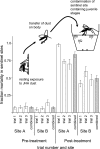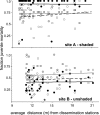Using adult mosquitoes to transfer insecticides to Aedes aegypti larval habitats
- PMID: 19561295
- PMCID: PMC2702255
- DOI: 10.1073/pnas.0901369106
Using adult mosquitoes to transfer insecticides to Aedes aegypti larval habitats
Abstract
Vector control is a key means of combating mosquito-borne diseases and the only tool available for tackling the transmission of dengue, a disease for which no vaccine, prophylaxis, or therapeutant currently exists. The most effective mosquito control methods include a variety of insecticidal tools that target adults or juveniles. Their successful implementation depends on impacting the largest proportion of the vector population possible. We demonstrate a control strategy that dramatically improves the efficiency with which high coverage of aquatic mosquito habitats can be achieved. The method exploits adult mosquitoes as vehicles of insecticide transfer by harnessing their fundamental behaviors to disseminate a juvenile hormone analogue (JHA) between resting and oviposition sites. A series of field trials undertaken in an Amazon city (Iquitos, Peru) showed that the placement of JHA dissemination stations in just 3-5% of the available resting area resulted in almost complete coverage of sentinel aquatic habitats. More than control mortality occurred in 95-100% of the larval cohorts of Aedes aegypti developing at those sites. Overall reductions in adult emergence of 42-98% were achieved during the trials. A deterministic simulation model predicts amplifications in coverage consistent with our observations and highlights the importance of the residual activity of the insecticide for this technique.
Conflict of interest statement
The authors declare no conflict of interest.
Figures





References
-
- WHO. Dengue and Dengue Haemorrhagic Fever. Geneva: WHO; 2008. WHO Fact Sheet 117.
-
- Anonymous. The feasibility of eradicating Aedes aegypti in the Americas. Rev Panam Salud Publica Pan Am J Public Health. 1997;1:68–72. - PubMed
-
- Ritchie S, et al. Dengue control in North Queensland, Australia: Case recognition and selective indoor residual spraying. Dengue Bull. 2002;26:7–13.
-
- WHO. Vector Control for Malaria and Other Mosquito Borne Diseases. Geneva: WHO; 1995. WHO Technical Report Series. - PubMed
Publication types
MeSH terms
Substances
Grants and funding
LinkOut - more resources
Full Text Sources
Other Literature Sources
Medical

